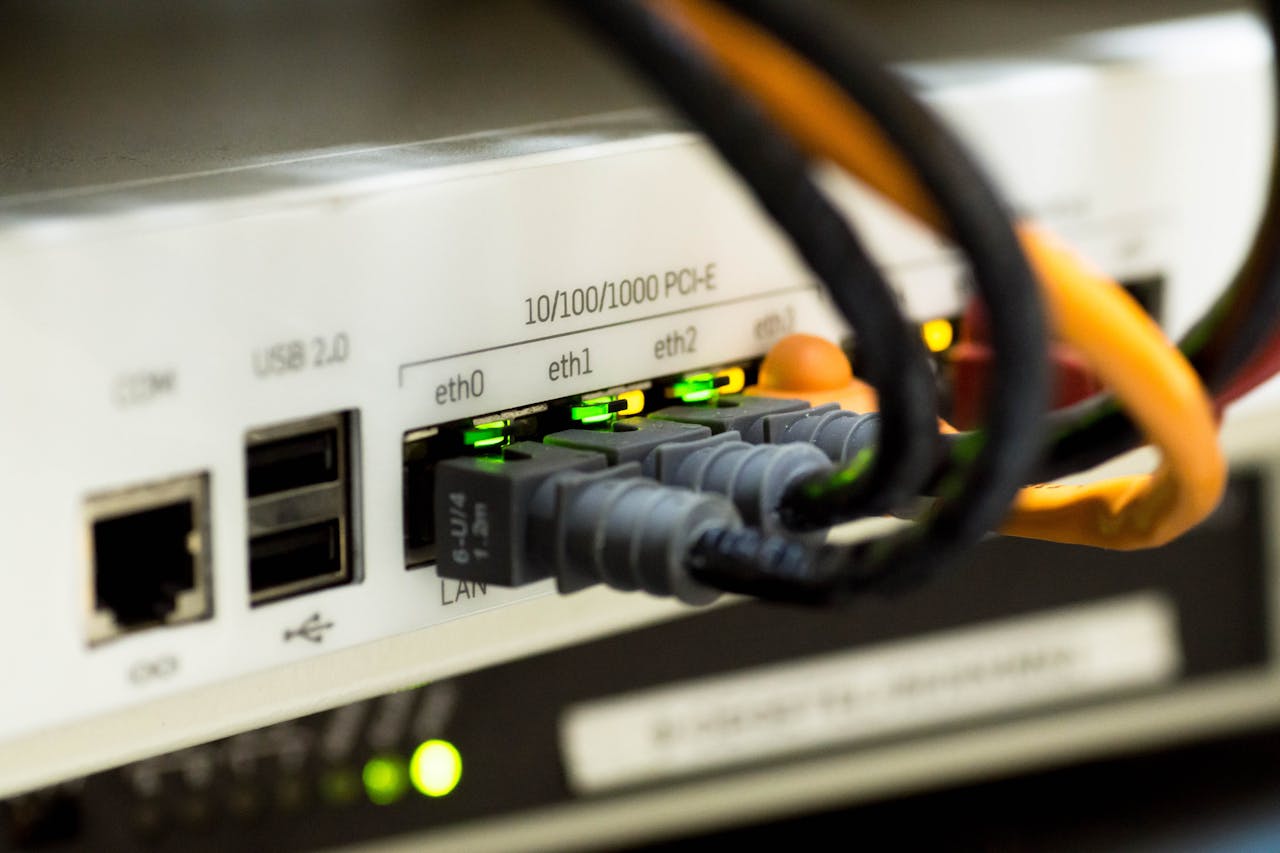Understanding the difference between a modem vs router is important for setting up a home or business network.
The modem must be compatible with the ISP’s infrastructure, while the router should satisfy the desired Wi-Fi coverage, speed requirements, and support for the number of devices that will be connected.
Let’s discuss these distinctions and their respective roles to better optimize a network’s performance and ensure reliable Internet connectivity.
Discover how VMedia’s no-contract internet plans can revolutionize your online experience. Click here to explore your options and find the perfect plan for you.
Understanding the Basics
Here are the roles that modems and routers play in connecting devices to the internet.
What is a Modem?
A modem (modulator-demodulator) is a device provided by an Internet Service Provider (ISP) that translates the incoming and outgoing internet signal.
Whether the connection is through DSL, cable, fibre, or an Optical Network Terminal (ONT) for fibre optics, the modem converts these signals to a digital format that a computer can understand and vice versa, handling analog signals for transmission over telephone lines or digital signals for newer technologies.
What is a Router?
A router directs traffic within a user’s network, either through Ethernet or Wi-Fi. Serving as a central hub, routers connect multiple devices and assign local IP addresses, allowing them to communicate with one another within a LAN (Local Area Network) and manage connections to the wider internet.
Wireless routers or Wi-Fi routers provide the additional functionality of supporting wireless connections, extending convenience and connectivity without the need for physical cables.
Functions and Roles
Modems and routers serve as essential components in networks, facilitating internet access and network traffic management.
Role of Modems
A modem functions as the gateway to the internet, acting as a translator between the digital data from a network and the analog signal from an Internet Service Provider (ISP). Here are the specific roles:
- Bridge to ISP: Modems connect directly to the internet via cables like coaxial, fibre optics, or telephone lines provided by the ISP.
- Translator: They convert analog signals from the ISP into digital signals that devices on the local network can understand, and vice versa.
- IP Address Assignment: Typically, the modem receives a public IP address assigned by the ISP, which uniquely identifies the network on the internet.
Role of Routers
Routers are responsible for creating and managing a local area network (LAN) by directing traffic to the appropriate devices. Their role entails:
- Traffic Director: Routers channel incoming and outgoing network traffic efficiently through Ethernet ports and/or Wi-Fi, ensuring data packets reach their destination.
- Wi-Fi Signal: They broadcast the Wi-Fi signal allowing wireless connection of multiple devices like smartphones, laptops, or smart TVs to the LAN.
- Security Features: Routers typically have built-in security features to safeguard the network from unauthorized access.
- Network Nodes Management: Assign private IP addresses to devices within the network, keeping internal traffic organized and enabling devices to connect to each other.
Each device ensures that users can access a stable internet, with modems acting as the primary gateway and routers as the managers of local network interactions.
Dive into the details of VMedia’s unlimited high-speed internet plans and see how they can upgrade your digital world. Get started now.

Comparing Features
When examining modems and routers, it is important to consider their features related to speed and performance, connectivity options, and security considerations. These aspects directly influence the efficiency and safety of a home or office network.
Speed and Performance
Modems are responsible for the connection to the internet and can significantly affect internet speeds. A modem’s capability is often determined by the maximum Mbps (megabits per second) or Gbps (gigabytes per second) it can handle. For instance, a modem that supports Gigabit Internet is essential for achieving the fastest speeds provided by an ISP.
Routers manage the distribution of the internet connection to various devices and can support different bandwidths. A router with Wi-Fi 6 technology is ideal for improving speed and performance, particularly in heavily device-laden networks.
| Device Type | Speed Factors |
| Modem | ISP Speed, Modem’s Mbps/Gbps Rating |
| Router | Supported Wi-Fi Standard, Bandwidth Capacity |
Connectivity Options
Modems typically provide a single Ethernet cable connection to a router. Conversely, routers offer multiple connectivity options including Ethernet ports for wired connections and wireless access for Wi-Fi devices. Devices like a Wi-Fi extender or a mesh system work with routers to enhance wireless reach and cover more areas effectively.
| Device Type | Connection Type |
| Modem | Single Ethernet Connection to the Router |
| Router | Ethernet, Wi-Fi, Extenders, Mesh Systems |
Security Considerations
A modem’s primary concern is to maintain a stable connection with an ISP, thus security features are generally implemented within the router. Modern routers are equipped with advanced security protocols to protect the network against unauthorized access.
Features like a built-in firewall, support for VPN (Virtual Private Networks) setups, and improved data encryption methods contribute significantly to a network’s protection.
| Device Type | Security Features |
| Modem | Basic ISP-level Security Features |
| Router | Firewall, VPN Support, Advanced Encryption Options |
Differences in Device Types
Understanding the distinct roles and configurations of modems and routers aids user’s needs in terms of layout, flexibility, and budget.
Separate Modem and Router
A stand-alone modem connects to the Internet Service Provider (ISP) to bring internet access into a home or office. It decodes the signal from the ISP and does not broadcast a Wi-Fi signal.
A separate router, on the other hand, creates a Local Area Network (LAN) by routing this internet connection to various devices via Wi-Fi or Ethernet. This setup offers significant flexibility as one can upgrade or replace one device without affecting the other.
- Advantages: Enhanced performance customization; potential for better range and signal strength.
- Considerations: Requires more space; may be more complex to set up.
Combination Devices
A modem-router combo integrates both functions into one unit, simplifying the layout and minimizing the equipment footprint. This option is convenient for users looking to streamline their network setup.
However, it may limit the ability to upgrade and flexibility since both devices are joined into a single unit.
- Advantages: Saves space; easier setup; often provided by ISPs.
- Considerations: Less customization; upgrades require replacing the entire unit.
Emerging Technologies
Recent tech news has highlighted the increasing roll-out of 5G technology and the development of mesh Wi-Fi router systems. Mesh Wi-Fi routers work with separate modems to provide extensive coverage throughout large or complex layouts without signal loss.
5G innovations might lead to new types of combination devices or even eliminate the need for traditional modems and routers in some instances.
- Advantages: Advanced coverage solutions; potential for harnessing faster speeds with 5G.
- Considerations: May be expensive; technologically advanced features could be unnecessary for average users.
Choosing the Right Equipment
Modems and routers are important for establishing reliable and scalable networks, whether for personal or business use.
For Home Networking
A homeowner should consider the number of devices that will be connected to the network, including smartphones, smart TVs, tablets, and smart devices. Home networks don’t usually require complex setups, but reliability is key.
A dual-band router is often sufficient for managing the connectivity and bandwidth demands of modern smart home devices. Meanwhile, a modem should be compatible with the internet service provider’s (ISP’s) requirements.
- Smart Home Essentials:
- Modem: Connects home to ISP.
- Router: Distributes internet to devices.
For Business Purposes
When dealing with enterprise equipment, scalability and reliability become more critical. A business must ensure that their network infrastructure can grow with their needs, handling more extensive device networks including printers, workstations, and commercial smart devices.
This often involves investing in more robust router and modem configurations, sometimes with advanced security features and dedicated technical support.
- Business Networking Must-Haves:
- Scalability: Network should support growth.
- Reliability: Downtime can be costly.
Equipment Rental vs. Purchase
The decision to rent or purchase network equipment can largely depend on a business or individual’s budget and technical expertise. Rental fees may provide a low upfront cost with the benefit of upgraded equipment as technology evolves.
Purchasing equipment can be a one-time investment that offers long-term savings, but may require more up-front technical knowledge or support. Users should evaluate the cost of equipment rental against the investment in purchase while considering their specific usage and technical support needs.
- Cost Considerations:
- Rental: Lower upfront cost, potential for upgraded models.
- Purchase: Higher upfront cost, long-term savings.

Troubleshooting and Maintenance
When dealing with modem and router issues, users often confront a series of common problems ranging from connection drops to outdated equipment. Effective troubleshooting and regular maintenance are crucial for a steady and reliable internet connection.
Common Issues
Connection drops and slow speeds are frequent issues indicating trouble with the modem or router. To diagnose, they should start with a speed test to check for inconsistencies in their internet speed. If the modem is the culprit, the speed will degrade directly after the modem.
If the router is at fault, the issue often lies within the realm of signal strength and Wi-Fi coverage. Users can check their signal strength to ensure it’s sufficient throughout the area of use.
- Troubleshooting Steps:
- Perform a speed test.
- Check signal strength in different locations.
- Restart the modem and router to refresh the connections.
- Eliminate potential interference sources like other wireless devices or physical obstructions.
- Change Wi-Fi channels on the router to find a less congested one.
Learn more about VMedia’s affordable internet solutions and how you can enjoy high-speed connectivity without overspending. Find your plan today.
Updating Equipment
Maintaining updated software and firmware is essential for security and performance. Users should regularly check the manufacturer’s website for updates for their modem and router.
Hardware upgrades can be necessary for those experiencing continued issues after software updates, or for those with equipment that’s no longer supported.
- Maintenance Checklist:
- Confirm that the modem and router firmware is up to date with the latest version.
- Evaluate if a hardware upgrade is a viable solution for persistent issues.
- Ensure that any new equipment is compatible with their internet service provider’s standards.
By addressing common issues with targeted troubleshooting and sustaining their equipment with updates and timely upgrades, users ensure a reliable and efficient network.
Related: How to Connect Router to Modem and Computer
Modem vs Router – Final Thoughts
For those navigating the complexities of modern internet requirements, VMedia stands out with its no-contract internet plans designed to cater to diverse needs.
Offering unlimited high-speed internet options, VMedia provides the flexibility to explore, upgrade, or change plans without the constraints of traditional contracts. This flexibility, combined with the understanding of modem and router functionalities, empowers users to optimize their home networks for peak performance and reliability.
Explore VMedia’s internet plans today and discover how you can enhance your online experience, from seamless streaming to efficient home office setups, all supported by state-of-the-art networking equipment.

